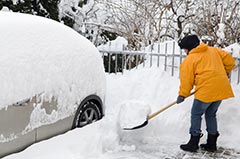AARP Hearing Center
Don't Fall! Tips for Staying Safe in Icy Conditions
By Candy Sagon, January 3, 2014 02:03 PM

Slips and falls during the winter months are all too common, say the orthopedists who take care of all the bone breaks, muscle tears and sprains that happen this season.
And now that the Northeast has been hammered with a monster storm, it's even more important for older folks to be careful about falling or suffering injuries while shoveling snow.
Keep in mind that 11,500 people are sent to the emergency room each year with snow-shoveling injuries, and those 55 or older are four times more likely to suffer cardiac-related symptoms than younger adults are.
>> Sign up for the AARP Health Newsletter
Orthopaedic surgeon James Gladstone, M.D., co-chief of sports medicine at New York's Icahn School of Medicine at Mount Sinai, offers these tips for staying safely on your feet:
- Do the shuffle. If you must walk on ice, walking in a shuffle or moving your feet only slightly apart provides better balance than your normal stride. Bending your knees just slightly as you walk will also help you keep your balance.
- Walk sideways on inclines. When walking on an icy incline such as a driveway, turn sideways. Then walk in side steps, by taking a step and bringing your other foot up to meet your lead foot, instead of your usual gait of one foot in front of the other. Walking this way while also slightly bending your knees will give you more balance and stability.
- Watch out for icy patches. Take care when exiting cars, buses and trains or when walking up and down outdoor stairs. Keep your eyes open for patches of ice.
If you must shovel snow, here are some tips for doing it safely:
- Warm up your muscles. Shoveling is a vigorous activity. Before you go outside, warm up your muscles with some light exercise for 10 minutes.
- Push, don't lift. Push the snow to the side as much as possible, instead of lifting it. If you must lift, do it properly. Squat with your legs apart, knees bent and back straight. Lift with your legs. Do not bend at the waist.
- Think small scoops. Small amounts of snow are easier to lift, and you're less likely to strain your back. Never hold a shovelful of snow with your arms outstretched - it puts too much weight on your spine.
- Avoid twisting. Do not throw the snow over your shoulder or to the side. This requires a twisting motion that stresses your back.
>> Get travel discounts with your AARP Member Advantages.
Photo: E+/Getty Images
Also of Interest
- These Web-Based Medical Apps Make House Calls
- Yellowstone's Caldera and 9 Other Top Natural Wonders in America
- Get free assistance with tax-return preparation from Tax-Aide
- Join AARP: Savings, resources and news for your well-being
See the AARP home page for deals, savings tips, trivia and more































































